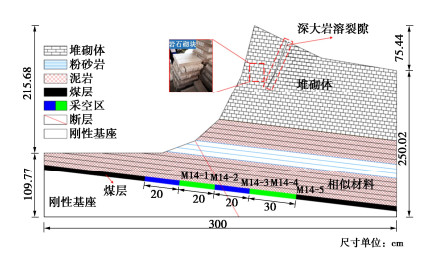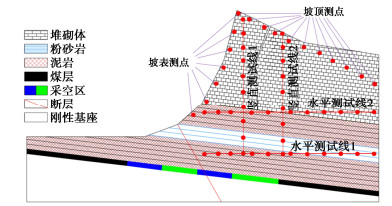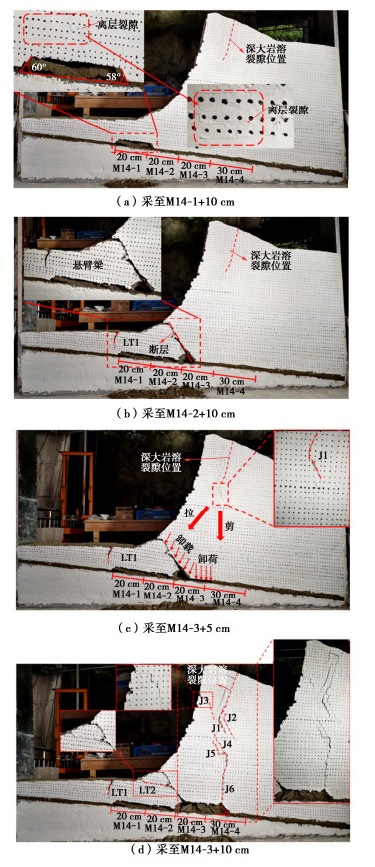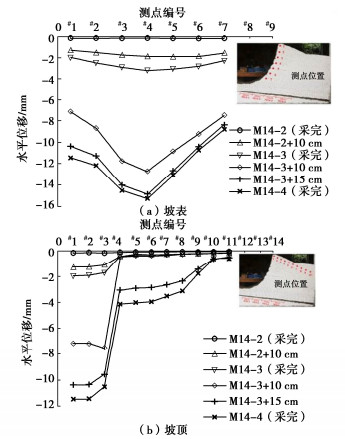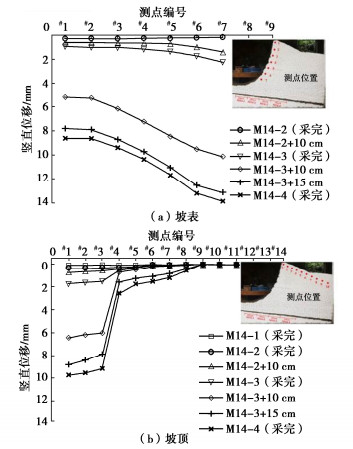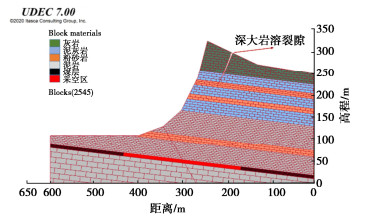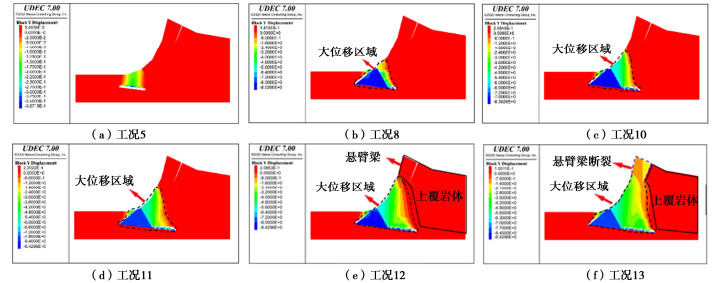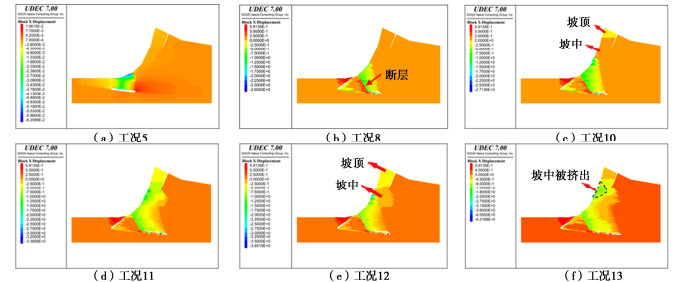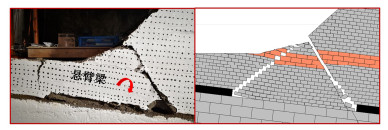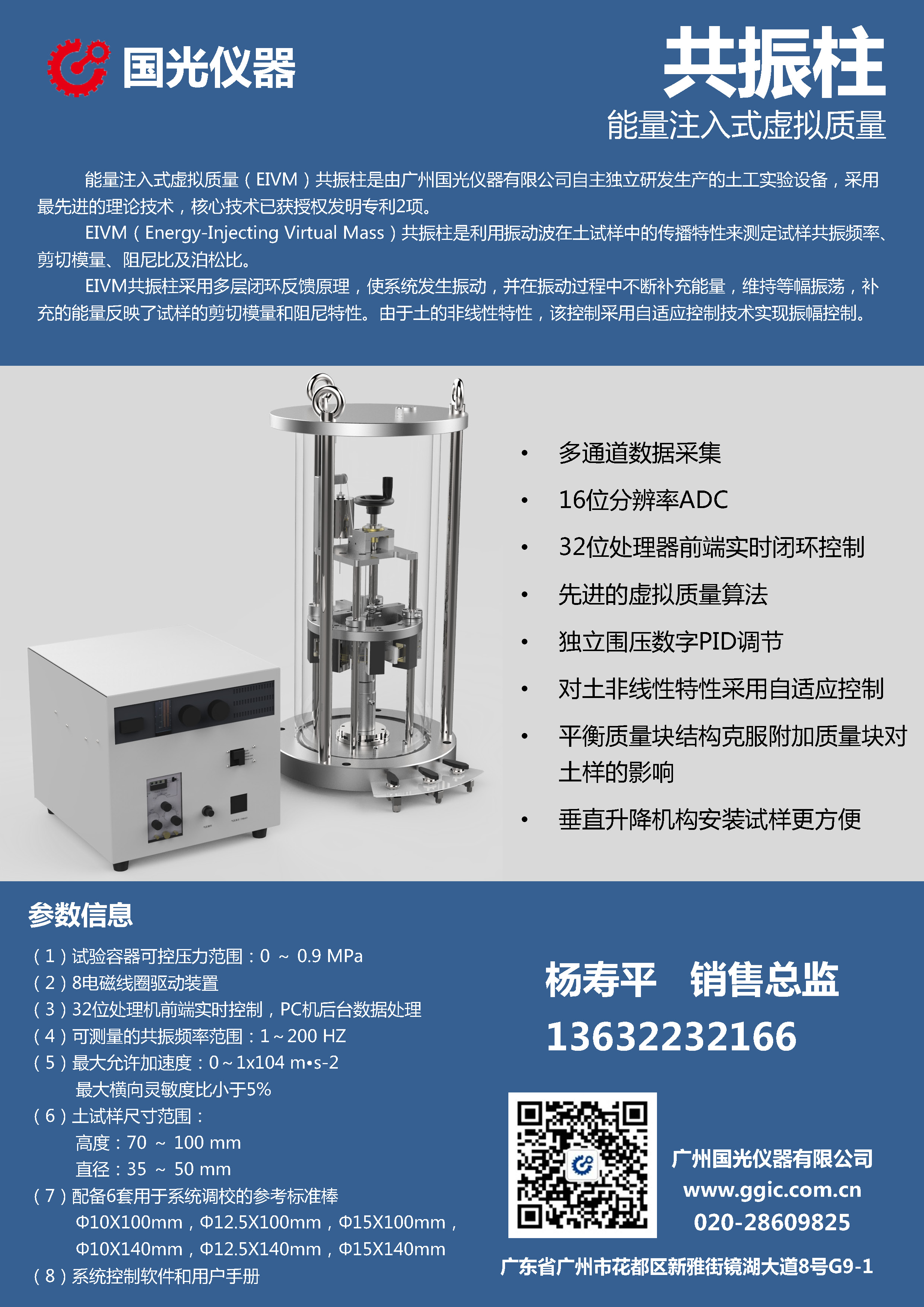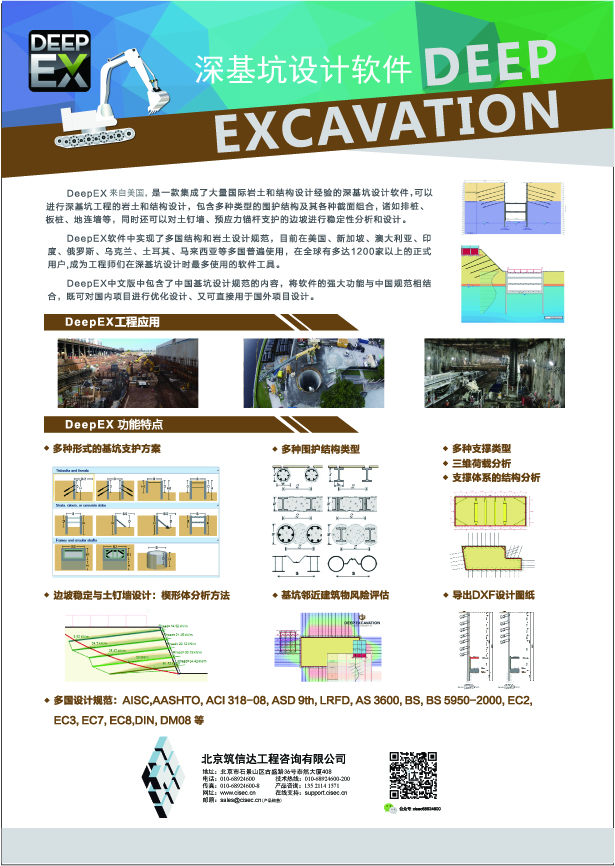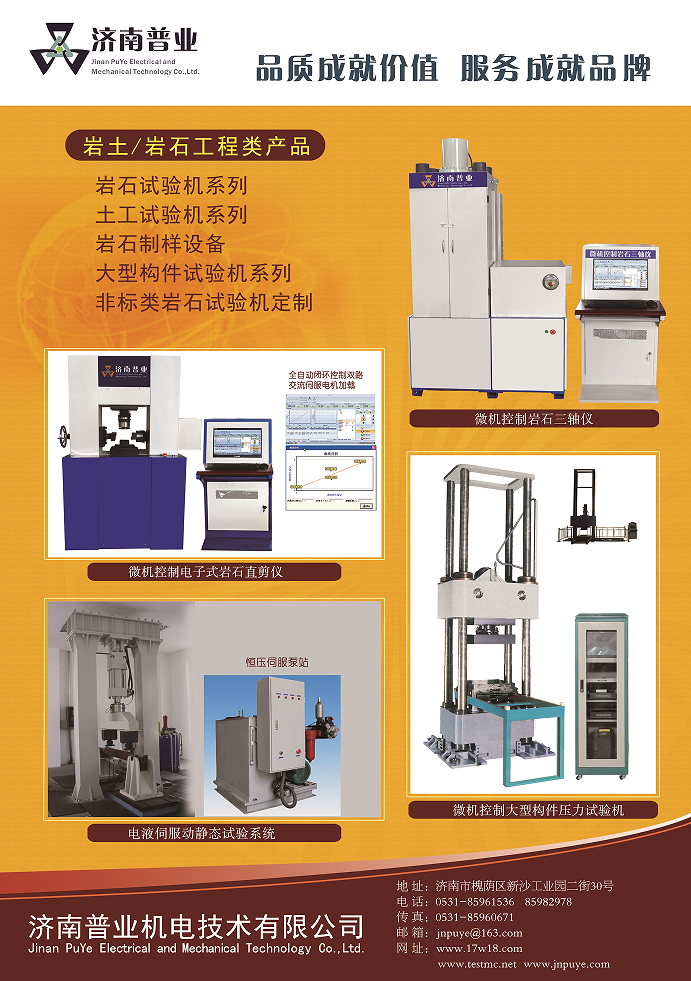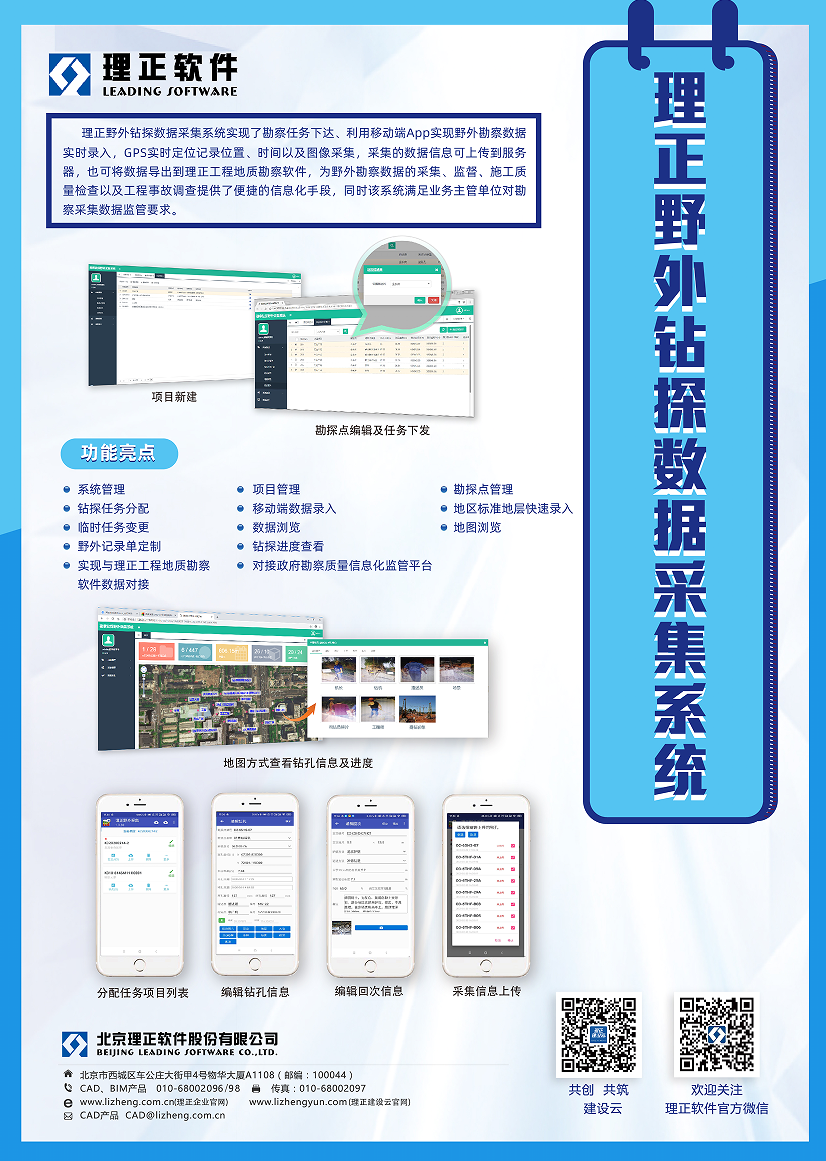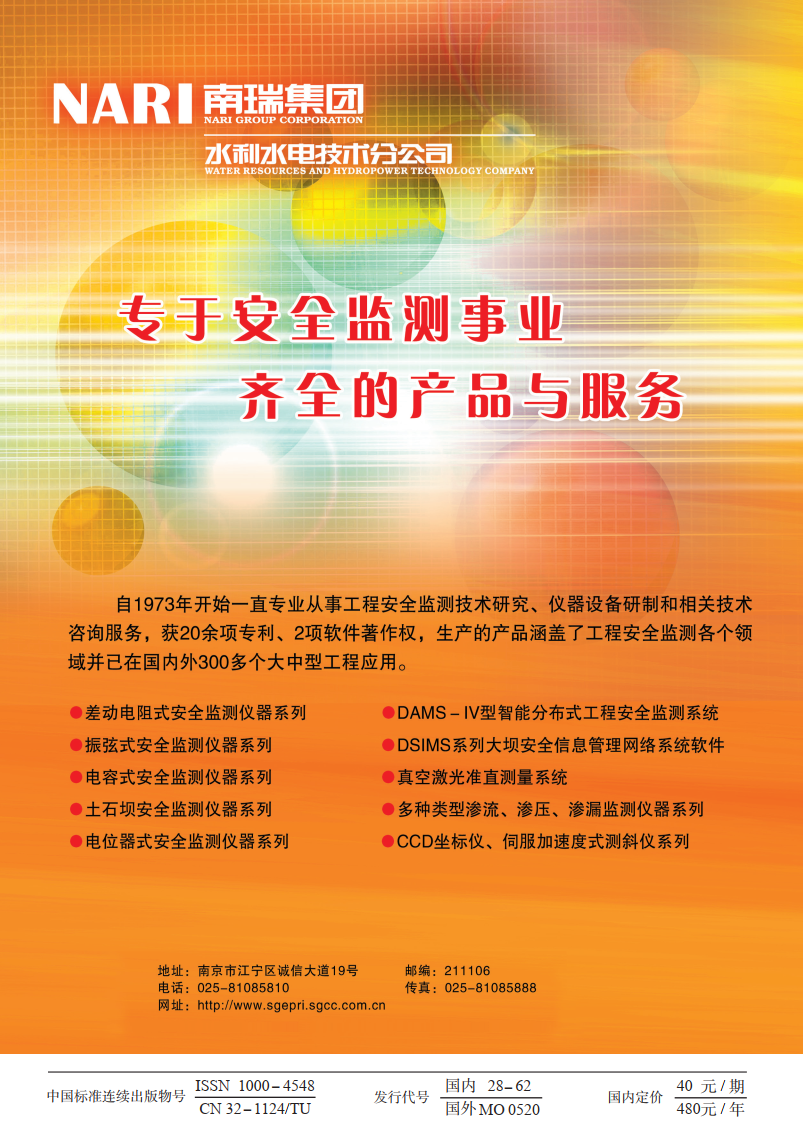Propagation of fissures and deformation and failure laws of karst slopes with deep and large structural plane mining action
-
摘要: 中国西南高陡岩溶山区崩滑灾害频发,长期地下采矿活动是该区域崩滑灾害的重要诱因之一。采动作用下,坡体后缘深大结构面扩展演化控制着高陡岩溶坡体稳定性和失稳破坏模式。在野外地质调查基础上,结合室内物理模型试验和离散元数值模拟,揭示了地下开采扰动下覆岩裂隙扩展演化规律,阐明了深大结构面对边坡稳定性的控制作用,讨论了坡体变形的破坏模式。结果表明:地下开采扰动对斜坡体稳定性的影响主要表现在地下采动卸荷引起覆岩应力重分布、山体变形诱使裂隙扩展;地下采空后,斜坡体在二维剖面上形成类似“悬臂梁结构”,坡体原有深大结构面控制坡体稳定性;下行开采条件下,采空范围在断层之前,山体高度较小,在自重作用下“悬臂梁结构”岩层向断层及采空区方向协同变形,不会产生大量离层裂隙,煤层顶板仅发生断裂坍塌并充填采空区,采空至断层后,左侧山体已发生塌落,山体应力重分布,覆岩在自重作用下形成大量张拉裂隙,直接顶塌落高度与裂隙带高度也随采空区范围增加而增加。其变形破坏演化过程可概化为:地下开采卸荷-应力重分布→覆岩断裂下沉-裂隙扩展→坡体裂隙贯通-悬臂破坏→坡中变形挤出-岩桥剪断→坡体整体失稳破坏。Abstract: Collapse and slide disasters frequently occur in high and steep karst mountainous areas in Southwest China. Long-term underground mining activities are one of the important inducements of the collapse and slide disasters in these areas. Under the action of mining, the expansion and evolution of deep and large structural plane at the back edge of the slope controls the stability and instability failure mode of high and steep karst slopes. On the basis of field geological survey, combined with indoor physical model tests and discrete element numerical simulation, the propagation and evolution laws of overlying rock fractures under underground mining disturbance are revealed, the control effects of deep and large structural plane on slope stability are expounded, and the failure modes of slope deformation are discussed. The results show that the influences of underground mining disturbance on slope stability are mainly reflected in the redistribution of overburden stresses caused by underground mining unloading and the propagation of fissures induced by mountain deformation. After underground mining, the slope body forms a "cantilever structure" on the two-dimensional section, and the original deep and large structural plane of the slope body controls the stability of the slope body. Under downward mining, the goaf range is in front of the fault, and the mountain height is small. Under the action of self weight, the "cantilever structure" rock stratum cooperates to deform towards the fault and goaf, and will not produce a large number of separation fissures. The coal seam roof only breaks and collapses and fills the goaf. After the goaf reaches the fault, the mountain at the left has collapsed and the mountain stresses are redistributed. The overburden forms a large number of tension fissures under the action of self weight, and the direct roof collapse height and fracture zone height also increase with the increase of goaf range. The evolution process of deformation and failure can be generalized as follows: underground mining unloading-stress redistribution→overburden fault subsidence-fissure propagation→slope fissure penetration-cantilever failure→deformation extrusion in the slope-rock bridge shear→overall instability failure of the slope.
-
Keywords:
- mining action /
- deep and large karst fissure /
- failure mode /
- UDEC /
- cantilever beam /
- similarity model test /
- slope
-
0. 引言
西南山区岩溶作用强烈、河谷深切、降雨集中,形成以高陡斜坡为主的地貌形态。由于特殊的地层形成历史,这些高陡斜坡往往具有“上硬下软”的地层结构和上陡下缓的“靴”型地貌特征[1]。且在漫长的构造、风化、卸荷、溶蚀等地质作用耦合作用下,坡体中常发育多条陡倾角外倾深大岩溶结构面,从而形成崩滑体的控制性边界,控制着地质灾害的失稳模式,为采动滑坡创造了有利条件[1-3]。
同时,西南岩溶山区是中国重要的能源基地,开采历史长,开采规模大,开采活动频繁。伴随着矿层采空区不断扩大,上覆山体持续变形[2-5],已诱发了多起大型岩质崩滑灾害,如武隆鸡冠岭滑坡[6]、武隆鸡尾山滑坡[7]、贵州关岭滑坡[8]、湖北鹤峰红莲池铁矿山体崩塌[9]、云南镇雄滑坡[10]等,造成了巨大人员伤亡和财产损失。大量研究表明,不良地质结构面控制着坡体稳定性。高陡岩质边坡的失稳破坏与岩体结构面的松动、扩展与贯通密切相关[11-12],因此,结构面控制型滑坡被认为是特大型岩质滑坡的主要类型[13]。2017年8月28日贵州纳雍县普洒煤矿矿区发生大型崩滑,滑坡体积约66×104 m3,造成35人遇难。调查发现,山体内部发育多条陡倾角外倾深大岩溶结构面,在大面积采动作用下,裂隙不断发育直至贯通,坡中岩体被挤出,坡体发生变形破坏,最终失稳。针对此类问题,国内外学者做了大量深入研究,Thomosn等[14]认为地下开采导致坡体覆岩产生不均匀沉降,坡体形成张拉裂隙,在降雨和地下水长期耦合作用下,裂隙不断扩展是诱发山体滑坡的主要原因。同时,地下采动导致坡体应力重分布,覆岩发生层面分离,并产生裂隙,强度降低[6],Jones等[15]通过数值模拟对南威尔士矿山滑坡灾害模拟分析也证实,采空区范围增大后,自重作用下顶板产生拉应力,使采空区上覆岩层中的层面、节理裂隙发生扩展,导致坡体安全系数降低。
以上研究均表明地下开采对山体应力调整具有显著作用,从而产生“悬臂效应”或“顶板冒落”[16-17],进而导致陡倾角外倾深大裂隙不断孕生,形成相互切割的多组结构面,从而孕育灾害体[6]。但对地下开采扰动下岩溶山体裂隙扩展与贯通的变形机制需进一步厘清,采动作用下深大结构面对坡体控滑机理及由深大岩溶裂隙控制的坡体变形破坏规律研究仍需深入。本文以纳雍普洒滑坡为工程背景,通过现场地质环境调研、室内模型试验和离散元数值模拟,揭示地下开采扰动下上覆岩层、裂隙扩展与坡体变形破坏规律,以期为西南岩溶山体的地质灾害防控提供参考。
1. 纳雍普洒滑坡概况
纳雍普洒滑坡发生于贵州省毕节市纳雍县普洒村。滑坡区内地势南高北低,坡顶标高2147 m,坡底标高1842 m,相对高差305 m,呈现出西南岩溶山区典型“靴”型地貌[1-3]。崩滑体位于岩溶坡体上部,自然坡度为55°~75°;岩溶坡体下部相对平缓,坡度为10°~25°[1-3]。
崩滑区内出露地层由新到老主要为第四系(Q4)、三叠系下统夜郎组(T1y1,T1y2)、二叠系上统长兴—大隆组(P2c+d)、二叠系上统龙潭组(P3l)。第四系覆土层主要为黏土、砂质黏土。山体上部的T1y1、T1y2、P2c+d灰岩、泥灰岩结构致密,力学强度高,抗风化能力强;山体下部的P3l泥岩强度较低,构成“上硬下软”岩体结构特征[1-3]。研究区地质剖面示意图如图 1所示。
2. 模型试验设计
2.1 试验模型
为探究地下开采扰动下上覆岩层、裂隙扩张与坡体变形破坏规律,通过地质调研对山体进行合理概化(图 2)。实际开采为多薄煤层开采,但煤层间距较小,单层采煤高度仅0.41.2 m,若根据模型几何相似比缩尺,则煤层高度过小,故本试验中将多薄煤层合并为M14位置上的单一煤层,开采总厚为8 m。地质调查及资料显示崩滑山体深大裂隙分布如图 1所示,其中第二条深大裂隙为滑坡主控裂隙,故在本试验中仅考虑该主控裂隙影响。如图 2所示,试验开采过程共设有4个工作面,即M14-1、M14-2、M14-3、M14-4,其中除M14-4工作面长度为30 cm,模拟60 m煤层长度外,其余工作面长度为20 cm,模拟40 m煤层长度。试验采用下行开采方式,中间未设煤柱,顶板管理方式为垮落法,每次开采长度为5 cm,待模型应力、变形稳定后进行下一次开采。
2.2 模型材料选取
普洒滑坡上部为节理较发育的灰岩等岩体,力学性能较好,但受节理切割形成块状结构,故坡体上部采用单元尺寸为30 cm×4 cm×3 cm的堆砌体进行模拟。采用河砂、石膏、腻子粉混合模拟煤层顶板;湿河砂模拟煤层。煤层底板为刚性稳定基础,用砖砌水泥浇灌。云母粉模拟岩体层面,模型单层岩体厚2~ 4 cm。
2.3 岩层物理力学性质及相似关系
试验中各岩层物理力学参数根据文献[1~3]及资料[18-20]确定,见表 1;根据文献[21]选取相似模拟材料,其试验参数见表 2;试验参数相似常数见表 3。
表 1 岩层物理力学参数Table 1. Physical and mechanical parameters of strata岩性 密度/(kg·m-3) 弹性模量/GPa 黏聚力/MPa 内摩擦角/(°) 抗拉强度/MPa 泊松比 灰岩 2700 31.28 8.16 45 2.90 0.30 泥灰岩 2450 25.62 6.53 39 1.60 0.28 粉砂岩 2650 20.00 7.52 35 2.40 0.24 泥岩 2460 6.00 5.86 32 1.40 0.26 煤层 1350 4.00 0.52 48 0.31 0.18 表 2 岩体及其相似配比材料的试验参数Table 2. Test parameters of stone and its similar materials岩层 密度ρ/(kg·m-3) 弹性模量E/GPa 粉砂岩 2650 20.000 泥岩 2460 6.000 粉砂岩相似材料 1780.5 0.104 泥岩相似材料 1640.6 0.034 表 3 试验参数的相似常数Table 3. Similarity constant of test parameters参数 相似关系 相似常数 密度ρ αρ 1.5 长度L αL 1/200 弹性模量E αE 1/200 应力σ ασ=αE 1/300 位移u αu=αL 1/200 2.4 试验设备及试验过程
(1)试验设备
本试验模型架长×宽×高为3 m×0.3 m×2 m,左、右及下侧均采用固定钢板约束模型位移,并借助光学散斑全场应变测量系统(XTDIC)观测坡体变形。
(2)试验过程
为更好地监测煤层开采后坡体位移变化,在坡体内部设置4条测线,取水平测线垂直位移变化量及竖直测线水平变化量分析坡体内部变形特点;取坡表临空面及坡顶各点位移变化量分析坡体外部变形特点,位移监测点布置图如图 3所示。
3. 结果分析与讨论
3.1 坡体变形破坏特征
试验过程中,随着煤层开采范围增加,直接顶悬空面积扩大,顶板形成以两端煤柱为支撑的固支梁结构,随后发生塌落;当开采至M14-1+10 cm时,由于采空区右侧含有断层且岩层倾斜,在自重作用下,断层被覆岩压密,采空区右上方覆岩发生较大位移,覆岩左上方产生离层裂隙(图 4(a))。
M14-2开采结束后,直接顶塌落范围增加约17 cm。M14-2+10 cm开采结束后,由于上覆岩层悬空面积较大,导致覆岩沿断层面松动,形成以覆岩左侧为固定端的悬臂梁结构(图 4(b)),采空区左端地表拉裂,形成张拉裂隙TL1,覆岩沿断层发生滑移、冒落。
M14-3+5cm开采结束后,采空范围继续增大,坡体卸荷,应力重分布,在拉应力与剪应力共同作用下,既有岩溶裂隙底部扩展萌生J1裂隙(图 4(c))。
煤层采至M14-3+10 cm时,坡体剧烈变形,顶板断裂垮塌,采空区覆岩处于悬臂弯曲受力状态, 覆岩发生自斜坡体表面斜向下的张拉断裂,形成裂隙J3,同时,在自重作用下,工作面煤壁前段为主要受压区,压应力集中,形成竖向压剪裂隙J6,并向下发展至垮落带。裂隙J3下方覆岩向左下方旋转下沉与断层下盘垮塌岩体接触形成支撑,由于上覆岩层自重较大,断层下盘垮塌岩体形成一条压剪离层裂隙LT2。采空区上覆岩层在下沉过程中形成自上而下的张拉裂隙J2、J4、J5,并使J1裂隙宽度增大(图 4(d))。
从此时岩溶坡体整体位移云图可知(图 5),由于采空区范围增大,煤层顶板垮落,覆岩在自重作用下形成张拉裂隙J2、J3、J4、J5以及竖向压剪裂隙J6,坡体上部左侧岩体沿深大裂隙滑动,坡中软岩部分被挤出,导致坡中位移部分最大,达15.72 mm。
M14-4开采结束时,受原深大岩溶裂隙右侧坡体受悬臂张拉作用,坡体后缘出现拉裂隙J7并向下延伸。同时在工作面煤壁前段受压区发生应力集中,再次形成一条竖向压剪裂隙J11,岩层沿J11下沉形成J8和J10两条自上而下拉裂隙。在坡体最左侧,图 6中红色区域危岩体继续沿深大岩溶裂隙滑动,J1、J2裂隙宽度逐渐增加并向下扩展,坡体下部岩体急剧下沉,冒落带被压实。
由于煤层开采顺序为下行开采,山体左侧高度较小,因此采空区上方覆岩在较小自重作用下,悬臂结构岩层向断层及采空区方向协同变形,不会产生大量离层裂隙,而当采空区范围扩大到山体中间时,山体受断层影响,左侧已发生“悬臂断裂”,山体塌落,导致应力重分布,在自重作用下则会产生大量张拉裂隙,最终山体失稳破坏。
3.2 坡体位移变化特征
斜坡部分特征点覆岩移动变形时空变化规律如图 7,8所示。图 7(a)显示,随M14-3和M14-4工作面的开采,坡体发生剧烈变形,坡表测点水平位移增大,且坡表中间测点#4的水平位移明显大于坡顶和坡表测点,这是由于坡体危岩体沿深大裂隙向下滑动,挤推坡表中间岩体,坡中岩体受上覆岩体的挤压而被临空挤出。可见深大裂隙是坡体变形破坏的主导因素。
图 7(b)可见,随采动进行,其影响范围由临空面不断向深部和坡表扩大,水平位移也随之增加,且测点与临空面距离越近,水平位移越大。M14-3开采结束时,已开采煤层上方测点水平位移发生明显变化。采至M14-3+10 cm处时,靠近坡体临空面各测点水平位移剧烈增加,这是因为采空区上覆岩体发生悬臂破坏,破坏岩体向左下旋转导致。随着采空区的增大,坡体发生大位移区域的范围也增加。
图 8(a)可看出随开采进行,坡体垂直变形也在不断增加,坡表各测点越靠近采空区,其垂直位移越大。当M14-3开采结束时,坡表下方测点垂直位移发生明显变化。采至M14-3+10 cm处时,上覆岩体发生悬臂破坏,破坏岩体下沉,导致坡表各测点位移剧烈增加。M14-4开采结束时,采空区达到最大,在自重作用下,冒落岩层被充分压实,其附近测点#7垂直位移最大。
水平测线各监测点垂直位移曲线(图 8(b))变化规律相似。M14-3开采结束时,采空区位于坡体下方,对坡体影响最大,故其上方测点垂直位移明显增加。采至M14-3+10 cm时,采空区范围增加,岩体发生垮塌,采空区上方测点垂直位移剧烈增加。测点#3位于深大裂隙左侧危岩体上,测点#4位于深大裂隙右侧,经上述分析可知危岩体沿深大裂隙发生滑移,因此测点#3垂直位移远大于测点#4。当工作面采完时,各测线垂直位移均达到最大,且最大值均位于临空面最外侧测点处,表明坡体岩层破坏形式主要为悬臂张拉破坏。
3.3 边坡变形破坏机理
通过现场调查与分析,可将普洒滑坡归类为缓倾层状岩溶山体塑流-拉裂崩滑破坏模式。该模式主要发生在上硬下软,上陡下缓的斜坡中。上部硬岩向下部软岩变形挤压,形成差异变形,导致覆岩裂隙张拉扩展,下部软岩受压挤出,最终使中部岩桥锁固段剪断,上覆硬岩拉裂解体从而造成大规模崩滑灾害(图 9)。塑流-拉裂式崩滑的岩质边坡主要有以下特征[22]:
(1)坡体上部硬岩强度较大,而坡体下部为软岩,厚度较大,由于长期差异性风化作用,形成了上陡下缓的地貌特征。
(2)上部硬岩近水平,且节理较为发育,山体后缘发育有近乎平行于坡体临空面的陡倾深大结构面。
(3)剪出口一般发育在下部软弱岩层中,呈圆弧或圈椅状,是由于软弱岩层在无侧限压缩情况下剪切破坏形成;上部硬岩破裂面一般沿坡体上部岩层中既有节理裂隙发育而成。
(4)坡体变形初期主要为下部软岩压裂鼓胀、塑流挤出破坏,上部硬岩缓慢沉降及深大裂隙张拉扩展。
(5)从坡体失稳过程看,上硬下软的地质结构和上陡下缓的地貌特征,使下部软岩发生挤压变形且沉降不均,上部硬岩结构面受拉张开,崩滑体不断向临空方向缓慢蠕动,致使软弱基座进一步受到挤压,能量不断积累,在地下采矿影响下,岩溶深大结构面进一步发育、张开、贯通,岩体结构松动,软弱基座变形卸荷并被压溃挤出,最终导致整体崩滑失稳。
可将模型试验变形破坏演化过程分为3个阶段:
(1)裂隙发育扩展阶段:采空区范围扩大,直接顶塌落。随着煤层采至斜坡体下方,覆岩逐渐悬空,当悬空面积达到极限,上覆岩层形成逐级渐进的至上而下的张拉断裂裂缝,且裂缝随采空范围的增加而不断扩张(图 10(a))。
(2)裂隙贯通-悬臂破坏阶段:煤层继续开采,直接顶塌落范围增加,覆岩向下移动变形,裂隙扩展贯通,上部悬臂结构破坏,断裂的危岩体沿着深大裂隙滑动(图 10(b))。
(3)失稳崩滑阶段:煤层开采结束后,覆岩加剧下沉,冒落带被不断压密,断裂危岩体沿深大裂隙滑动,中间岩层受到推挤作用使坡中压剪应力集中,坡体沿深大裂隙底部向临空面剪断,山体顶部岩体由于下部软岩变形卸荷被向外倾倒解体,整个山体出现拉剪滑移-倾倒式崩滑破坏(图 10(c))。
4. 坡体破坏数值模拟分析
4.1 模型建立
针对纳雍工程地质特征,采用离散元软件UDEC研究采动作用下坡体位移场演化。节理产状取310°∠7°,节理间距取4~6.2 m,正交次级节理取8~12 m,设置一条深大裂隙(如图 11)。煤岩采用莫尔-库仑模型,节理采用莫尔-库仑面接触滑移模型。固定模型左右及下边界,初始应力场为重力场,g=9.81 m/s2。岩体、节理物理力学参数分别见表 1,4。综合地质背景对实际山体进行合理简化,仅开采M14号煤层,开采总厚为8 m,长度为260 m,未设煤柱,共开挖13次。
表 4 结构面物理力学参数表Table 4. Physical and mechanical parameters of structural plane节理类型 法向刚度系数/GPa 切向刚度系数/GPa 黏聚力/MPa 内摩擦角/(°) 抗拉强度/MPa 煤层交界面 12.0 2.7 0.08 14 0.12 其他交界面 28.0 8.4 0.09 24 0.16 灰岩节理 32.0 9.6 0.92 35 0.94 泥灰岩节理 27.0 8.2 0.78 29 0.69 粉砂岩节理 23.0 7.5 0.24 25 0.15 泥岩节理 19.0 6.3 0.19 23 0.13 4.2 坡体位移场演化分析
对数值模拟结果进行处理并分析,部分开挖步开采结束时,坡体垂直和水平位移云图分别如图 12,13所示,每个工况开挖20 m。
由图 12可知,工况5结束后,采空区离岩溶坡体较远,对山体影响较小,但顶板下沉明显。工况8结束后,断层下盘岩体发生悬臂梁断裂,整体垮塌。工况10结束后,煤层开挖至岩溶坡体下方,坡体产生较大垂直位移,且随着采空区增大,坡体上部垂直位移范围逐渐扩张。工况12结束后,上覆岩体逐渐形成一个类似悬臂梁结构,但因上方有深大裂隙,故悬臂结构易失稳。工况13结束后,悬臂结构发生断裂,危岩体沿深大裂隙滑动,坡体失稳破坏。
图 13可见,工况5结束后,采动作用对坡体影响较小,最大位移发生在坡脚,为0.06 m。工况8结束后,断层下盘岩体整体垮塌,断层上盘岩体向左下方移动,坡脚位移增至1.25 m。工况10结束时,采空区到达坡体正下方,坡顶水平移动较明显,达0.25 m。工况11结束后,坡体左侧水平位移继续增加,坡顶最大水平位移达0.5 m,坡中最大水平位移达0.25 m。工况12结束后,坡顶最大水平位移增加较小,而坡中最大水平位移明显增加,达0.75 m。当工况13结束后,采空区范围达到最大,坡体形成的悬臂结构发生破坏,危岩体沿深大裂隙滑动,坡中岩体被挤出,因此坡体最大水平位移出现在坡中。
4.3 数值模拟与模型试验对比分析
物理模型试验结果同数值模拟结果坡体破坏规律一致。由图 14可知,当煤层采至坡体断层处时,由于断层下盘岩体发生悬臂梁断裂,岩体均发生垮塌。
随着采空区范围扩大,坡体下部岩体发生塌落,坡顶形成悬臂梁结构(图 15(a))。数值模拟也出现了同模型试验类似的悬臂梁结构(图 15(b))。
煤层继续开采,模型试验与数值模拟均在深大裂隙底部产生裂隙,并向右下方扩展,如图中K1、K2和M1、M2。且两者均在深大裂隙左侧危岩体上自临空面向右下方形成张拉裂隙K3和M3(图 16)。
采空区达到最大时,如图 17所示。两者坡体破坏模式基本一致,覆岩塌落后破坏了上部悬臂梁结构的稳定,断裂的危岩体沿深大裂隙滑动,并推挤坡中岩层,导致坡中压剪应力高度集中,斜坡体沿深大裂隙底部向临空面发生剪断,导致坡中岩体被挤出,山体顶部岩体由于下部软件变形卸荷向外倾倒解体,整个山体出现拉剪滑移-倾倒式崩滑破坏。
5. 结论
(1)采动作用对岩溶坡体稳定性影响主要表现在:随着采空区增大,岩溶坡体发生应力重分布,深大岩溶裂隙底部易形成应力集中,从而裂隙扩张,危岩体发生滑动,使坡中岩体向临空面挤出,当原深大裂隙与临空面贯通,坡体发生失稳。
(2)深大岩溶裂隙对坡体破坏变形占据主导因素,随着开采范围增加,岩溶坡体上部逐渐形成类似悬臂梁结构,并沿深大裂隙发生断裂,危岩体始终沿着深大结构面滑动。
(3)在下行开采的顺序下,采空范围扩展到断层之前,由于山体左侧高度较小,覆岩在较小的自重作用下,悬臂结构的岩层向断层及采空区方向协同变形,不会产生大量离层裂隙,当采空区扩展到山体中央即断层后方时,左侧山体已经发生塌落,山体应力重分布,覆岩在自重作用下,形成了大量张拉裂隙,且坡体内部煤层采空区范围越大,直接顶塌落高度越高,裂隙带高度也随之增加。
(4)根据模型试验变形特征,岩溶坡体变形破坏演化过程可概括为裂隙发育扩展→坡体裂隙贯通-悬臂破坏→坡体失稳破坏,与“8.28普洒特大崩滑灾害”破坏模式基本一致。
-
表 1 岩层物理力学参数
Table 1 Physical and mechanical parameters of strata
岩性 密度/(kg·m-3) 弹性模量/GPa 黏聚力/MPa 内摩擦角/(°) 抗拉强度/MPa 泊松比 灰岩 2700 31.28 8.16 45 2.90 0.30 泥灰岩 2450 25.62 6.53 39 1.60 0.28 粉砂岩 2650 20.00 7.52 35 2.40 0.24 泥岩 2460 6.00 5.86 32 1.40 0.26 煤层 1350 4.00 0.52 48 0.31 0.18 表 2 岩体及其相似配比材料的试验参数
Table 2 Test parameters of stone and its similar materials
岩层 密度ρ/(kg·m-3) 弹性模量E/GPa 粉砂岩 2650 20.000 泥岩 2460 6.000 粉砂岩相似材料 1780.5 0.104 泥岩相似材料 1640.6 0.034 表 3 试验参数的相似常数
Table 3 Similarity constant of test parameters
参数 相似关系 相似常数 密度ρ αρ 1.5 长度L αL 1/200 弹性模量E αE 1/200 应力σ ασ=αE 1/300 位移u αu=αL 1/200 表 4 结构面物理力学参数表
Table 4 Physical and mechanical parameters of structural plane
节理类型 法向刚度系数/GPa 切向刚度系数/GPa 黏聚力/MPa 内摩擦角/(°) 抗拉强度/MPa 煤层交界面 12.0 2.7 0.08 14 0.12 其他交界面 28.0 8.4 0.09 24 0.16 灰岩节理 32.0 9.6 0.92 35 0.94 泥灰岩节理 27.0 8.2 0.78 29 0.69 粉砂岩节理 23.0 7.5 0.24 25 0.15 泥岩节理 19.0 6.3 0.19 23 0.13 -
[1] 杨忠平, 蒋源文, 李滨, 等. 采动作用下岩溶山体深大裂隙扩展贯通机理研究[J]. 地质力学学报, 2020, 26(4): 459-470. https://www.cnki.com.cn/Article/CJFDTOTAL-DZLX202004003.htm YANG Zhong-ping, JIANG Yuan-wen, LI Bin, et al. Study on the mechanism of deep and large fracture propagation and transfixion in Karst slope under the action of mining[J]. Journal of Geomechanics, 2020, 26(4): 459-470. (in Chinese) https://www.cnki.com.cn/Article/CJFDTOTAL-DZLX202004003.htm
[2] 熊飞, 刘新荣, 冉乔, 等. 采动-裂隙水耦合下含深大裂隙岩溶山体失稳破坏机理[J]. 煤炭学报, 2021, 46(11): 3445-3458. https://www.cnki.com.cn/Article/CJFDTOTAL-MTXB202111005.htm XIONG Fei, LIU Xin-rong, RAN Qiao, et al. Instability failure mechanism of Karst Mountain with deep and large fissures under the mining-fissure water coupling[J]. Journal of China Coal Society, 2021, 46(11): 3445-3458. (in Chinese) https://www.cnki.com.cn/Article/CJFDTOTAL-MTXB202111005.htm
[3] 钟祖良, 高国富, 刘新荣, 等. 地下采动下含深大裂隙岩溶山体变形响应特征[J]. 水文地质工程地质, 2020, 47(4): 97-106. https://www.cnki.com.cn/Article/CJFDTOTAL-SWDG202004012.htm ZHONG Zu-liang, GAO Guo-fu, LIU Xin-rong, et al. Deformation response characteristics of Karst mountains with deep and large fissures under the condition of underground mining[J]. Hydrogeology & Engineering Geology, 2020, 47(4): 97-106. (in Chinese) https://www.cnki.com.cn/Article/CJFDTOTAL-SWDG202004012.htm
[4] 代张音, 唐建新, 江君, 等. 地下采空诱发含软弱夹层顺层岩质斜坡变形破裂的相似模拟[J]. 煤炭学报, 2016, 41(11): 2714-2720. https://www.cnki.com.cn/Article/CJFDTOTAL-MTXB201611008.htm DAI Zhang-yin, TANG Jian-xin, JIANG Jun, et al. Similarity modeling on instability and failure of rock bedding slope with weak interlayer caused by underground mining[J]. Journal of China Coal Society, 2016, 41(11): 2714-2720. (in Chinese) https://www.cnki.com.cn/Article/CJFDTOTAL-MTXB201611008.htm
[5] DO T N, WU J H. Simulating a mining-triggered rock avalanche using DDA: a case study in Nattai North, Australia[J]. Engineering Geology, 2020, 264: 105386. doi: 10.1016/j.enggeo.2019.105386
[6] 李滨, 王国章, 冯振, 等. 地下采空诱发陡倾层状岩质斜坡失稳机制研究[J]. 岩石力学与工程学报, 2015, 34(6): 1148-1161. https://www.cnki.com.cn/Article/CJFDTOTAL-YSLX201506009.htm LI Bin, WANG Guo-zhang, FENG Zhen, et al. Failure mechanism of steeply inclined rock slopes induced by underground mining[J]. Chinese Journal of Rock Mechanics and Engineering, 2015, 34(6): 1148-1161. (in Chinese) https://www.cnki.com.cn/Article/CJFDTOTAL-YSLX201506009.htm
[7] 殷跃平. 斜倾厚层山体滑坡视向滑动机制研究: 以重庆武隆鸡尾山滑坡为例[J]. 岩石力学与工程学报, 2010, 29(2): 217-226. https://www.cnki.com.cn/Article/CJFDTOTAL-YSLX201002002.htm YIN Yue-ping. Mechanism of apparent dip slide of inclined bedding rockslide—a case study of Jiweishan rockslide in Wulong, Chongqing[J]. Chinese Journal of Rock Mechanics and Engineering, 2010, 29(2): 217-226. (in Chinese) https://www.cnki.com.cn/Article/CJFDTOTAL-YSLX201002002.htm
[8] 殷跃平, 朱继良, 杨胜元. 贵州关岭大寨高速远程滑坡—碎屑流研究[J]. 工程地质学报, 2010, 18(4): 445-454. doi: 10.3969/j.issn.1004-9665.2010.04.002 YIN Yue-ping, ZHU Ji-liang, YANG Sheng-yuan. Investigation of a high speed and long run-out rockslide-debris flow at Dazhai in Guanling of Guizhou Province[J]. Journal of Engineering Geology, 2010, 18(4): 445-454. (in Chinese) doi: 10.3969/j.issn.1004-9665.2010.04.002
[9] 王章琼, 晏鄂川, 尹晓萌, 等. 层状反倾岩质边坡崩塌机理研究: 以湖北鹤峰红莲池铁矿边坡为例[J]. 中南大学学报(自然科学版), 2014, 45(7): 2295-2302. https://www.cnki.com.cn/Article/CJFDTOTAL-ZNGD201407022.htm WANG Zhang-qiong, YAN E-chuan, YIN Xiao-meng, et al. Study on collapse mechanism of anti inclined rock slope: a case study of Honglianchi Iron Mine slope in Hefeng, Hubei Province[J]. Journal of Central South University (Science and Technology), 2014, 45(7): 2295-2302. (in Chinese) https://www.cnki.com.cn/Article/CJFDTOTAL-ZNGD201407022.htm
[10] 殷跃平, 刘传正, 陈红旗, 等. 2013年1月11日云南镇雄赵家沟特大滑坡灾害研究[J]. 工程地质学报, 2013, 21(1): 6-15. doi: 10.3969/j.issn.1004-9665.2013.01.002 YIN Yue-ping, LIU Chuan-zheng, CHEN Hong-qi, et al. Investigation on catastrophic landslide of January 11, 2013 at Zhaojiagou, Zhenxiong County, Yunnan Province[J]. Journal of Engineering Geology, 2013, 21(1): 6-15. (in Chinese) doi: 10.3969/j.issn.1004-9665.2013.01.002
[11] CHEN L L, ZHANG W G, ZHENG Y, et al. Stability analysis and design charts for over-dip rock slope against bi-planar sliding[J]. Engineering Geology, 2020, 275: 105732. doi: 10.1016/j.enggeo.2020.105732
[12] 龙建辉, 任杰, 曾凡桂, 等. 双软弱夹层岩质滑坡的滑动模式及变形规律[J]. 煤炭学报, 2019, 44(10): 3031-3040. https://www.cnki.com.cn/Article/CJFDTOTAL-MTXB201910010.htm LONG Jian-hui, REN Jie, ZENG Fan-gui, et al. Sliding mode and deformation law of double weak interlayer rock landslide[J]. Journal of China Coal Society, 2019, 44(10): 3031-3040. (in Chinese) https://www.cnki.com.cn/Article/CJFDTOTAL-MTXB201910010.htm
[13] HUNGR O, EVANS S G. The occurrence and classification of massive rock slope failure[J]. Felsbau, 2004, 22(2): 16-23.
[14] THOMSON S, YACYSHYN R. Slope instability in the city of Edmonton[J]. Canadian Geotechnical Journal, 1977, 14(1): 1-16. doi: 10.1139/t77-001
[15] JONES D B, REDDISH D J, SIDDLE H J, et al. Landslides and Undermining: slope stability interaction with mining[C]// Proceedings 7th Int Soc Rock Mechanics Congress. Ratterdam, 1992.
[16] 刘传正. 重大地质灾害防治理论与实践[M]. 北京: 科学出版社, 2009: 287-493. LIU Chuan-zheng. Theory and its Application on Mega-Geo-Hazards Mitigation[M]. Beijing: Science Press, 2009: 287-493. (in Chinese)
[17] 孙玉科, 姚宝魁. 盐池河磷矿山体崩坍破坏机制的研究[J]. 水文地质工程地质, 1983, 10(1): 1-7. https://www.cnki.com.cn/Article/CJFDTOTAL-SWDG198301000.htm SUN Yu-ke, YAO Bao-kui. Mechanicsm research on the collapse of Yanchi river mining area[J]. Hydrogeology and Engineering Geology, 1983, 10(1): 1-7. (in Chinese) https://www.cnki.com.cn/Article/CJFDTOTAL-SWDG198301000.htm
[18] 贵州省地矿局第二工程勘察院. 贵州纳雍县地质灾害调查与区划报告[EB/OL]. http://www.nagac.org.cn/.2003,10. Second Engineering Investigation Institute of Guizhou Brareau of Geology and Mineral Resources. Investigation and regionalization of geological hazards in Nayong County, Guizhou Province[EB/OL]. http://www.nagac.org.cn/.2003,10. (in Chinese)
[19] 李振峰, 靳晓敏. 应用UDEC进行顶板"三带"范围划分的数值模拟研究[J]. 矿业安全与环保, 2015, 42(4): 21-24. doi: 10.3969/j.issn.1008-4495.2015.04.006 LI Zhen-feng, JIN Xiao-min. Numerical simulation research on scope division of "three zones" in roof with UDEC[J]. Mining Safety & Environmental Protection, 2015, 42(4): 21-24. (in Chinese) doi: 10.3969/j.issn.1008-4495.2015.04.006
[20] 谢小平, 刘晓宁, 梁敏富. 基于UDEC数值模拟实验的保护层无煤柱全面卸压开采分析[J]. 煤矿安全, 2020, 51(2): 208-212. https://www.cnki.com.cn/Article/CJFDTOTAL-MKAQ202002046.htm XIE Xiao-ping, LIU Xiao-ning, LIANG Min-fu. Study on overall pressure relief mining without pillar in protective layer through UDEC numerical simulation experiment[J]. Safety in Coal Mines, 2020, 51(2): 208-212. (in Chinese) https://www.cnki.com.cn/Article/CJFDTOTAL-MKAQ202002046.htm
[21] 赵志云, 赵冉, 白浩. 开采边坡在逆坡开采条件下的稳定性分析[J]. 煤矿安全, 2018, 49(8): 251-253, 257. https://www.cnki.com.cn/Article/CJFDTOTAL-MKAQ201808065.htm ZHAO Zhi-yun, ZHAO Ran, BAI Hao. Stability analysis of mining slope under reverse slope mining[J]. Safety in Coal Mines, 2018, 49(8): 251-253, 257. (in Chinese) https://www.cnki.com.cn/Article/CJFDTOTAL-MKAQ201808065.htm
[22] 李滨, 冯振, 张勤. 岩溶山区特大崩滑灾害成灾模式与早期识别研究[M]. 北京: 科学出版社, 2016. LI Bin, FENG Zhen, ZHANG Qin. Research on Disaster-Causing Mode and Early Indentification of Catastrophic Landslide Disaster in Karst Mountainous Area[M]. Beijing: Science Press, 2016. (in Chinese)
-
期刊类型引用(6)
1. LIU Xinrong,WANG Hao,XIONG Fei,LUO Xinyang. Deformation and failure mechanism of karst mountain with deep and large fissures under multi-coal seam mining: Insight from DEM simulation. Journal of Mountain Science. 2025(03): 950-965 .  必应学术
必应学术
2. 石玉玲,侯明杰,李怀鑫,晏长根,文奎. 断层斜交岩质高边坡开挖变形特征及其治理效果评价——以陕南地区某岩质高边坡为例. 地球科学与环境学报. 2024(03): 400-413 .  百度学术
百度学术
3. 念熙博,李宏杰,李伟,闫杰,郭夏飞,贾正昭. 侧向正交开采扰动边坡变形演变机理与破坏模式研究. 煤矿安全. 2024(08): 146-152 .  百度学术
百度学术
4. 赵瑞欣,代玉婷,李滨,易连兴,张秀钰. 考虑岩溶管道影响的山体滑坡稳定性研究. 工程地质学报. 2024(05): 1607-1617 .  百度学术
百度学术
5. 匡俊,杨涛,谭瑞. 苏州阳山东侧滑坡变形对下部采空区的响应分析. 南通大学学报(自然科学版). 2023(01): 77-85 .  百度学术
百度学术
6. 任高峰,王鑫,周汉红,邓德志,廖兵,向小东,胡世士,张聪瑞,SAMI Kakar,THEONESTE Ndayiragije. 爆破作用下岩溶对边坡稳定性的数值模拟研究. 爆破. 2023(04): 192-200 .  百度学术
百度学术
其他类型引用(9)



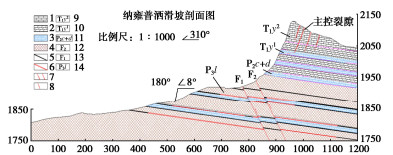
 下载:
下载:
